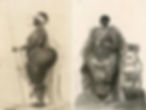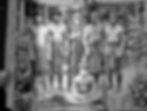The History of the Human Zoo
- J D
- Jun 8, 2021
- 4 min read
By Jessica Dropkin

Merriam Webster’s Dictionary has quite a few definitions for the word exotic, most in reference to food, plants or animals. However, when you use the term ‘Exotic’ to describe a person or a culture it is actually racist. This term stems from colonization in history when it was usually used to describe a human being. One defines ‘Exotic’ as “introduced from another country” which means calling a person exotic is saying they are not from your world, and must be from somewhere else. It is saying you see this person as another, is dehumanizing and it is objectifying a human being.
This word should be reserved for things, such as plants, objects and artifacts. Women in general have been treated like objects throughout history but women of other cultures were treated far worse, and considered “exotic”, as if they're a prized, rare fish to catch and display.
From the late 1800's to around the 1950's, there were human zoos internationally. From Europe to New York, there were people of color (POC) residing in zoos and museums as living exhibits. They were Africans, Asians, Latin Americans and Indigenous people. They were on display, clothed or nude, in “naturalistic” man-made habitats purported to look as close to each captive POC’s homeland. Spectators would pet and photograph them because they viewed these people as 'exotic animals'. POC were held captive for having body parts, sizes or shapes, considered “unusual” to the non-POC eye.


In 1906 at the Bronx Zoo in New York City, there was an exhibit called “The Monkey House”. This was essentially a human zoo. Among other captive people, who were all in different makeshift, artificial exhibits of their homelands, there was a Congolese man named Ota Benga who was put on display with a monkey. People that came to see these exhibits gawked and ogled. They used his cultural practices as a show for the public such as using his archery skills and weaving skills as a performance act. These people placed him in the same category as an animal and dehumanized him.


Similar to Ota Benga, Saartjie Baartman was also placed on display as a living, breathing exhibit. Baartman was a black woman who had a health condition called Steatopygia. Steatopygia is an excessive development and build up of fat in the lower areas of the body commonly in women of African descent. Due to Baartman’s symptoms, her body features were put on display at London’s Piccadilly Circus as an attraction for the public eye.

Her private areas and large buttocks were considered ‘exotic’, and unusual. Wealthy customers paid for private shows in their homes where she was touched like a pet. When she died at age 26, a plaster cast of her body was made before her autopsy. Her skeleton, brain, and genitals were preserved in pickling juice and jars. They were placed on display at Paris’s ‘Museum of Man’ until the year 1974. In 2002, her remains were removed and taken back to the Eastern Cape Province to be buried.
Reverend James H. Gordon, superintendent of the Howard Colored Orphan Asylum in Brooklyn, voiced his disapproval of these exhibits and said “Our race, we think, is depressed enough without exhibiting one of us with the apes. We think we are worthy of being considered human beings, with souls.”.
Because of this history, the word exotic is still used to refer to POC in consumerism and in conversations.
While a person using the word exotic to describe a person of another race and culture than their own may seem like a harmless compliment, it's actually a backhanded compliment. It is a reminder that they are less human and less real compared to non POC. It points out their race as being of wonder, as if they're a sideshow act at a circus that you can't see anywhere else. It's demoralizing and is viewing and labeling a person as an object. This results in what's called 'otherization'.
Othering and otherization is defined as categorizing a living, conscious being as something abnormal. This can happen when describing a POC and their physical features. Comparisons of their physical features to food or objects is a common occurrence. This could be from saying things such as one person has almond eyes, silky or kinky hair, or chocolate skin.

A human is not food, a plant, or a rare artifact.
A human is a person.
Human beings are not objects, they are people that deserve to be treated like they aren't a different species. The more we decolonize the word exotic from our vocabularies the closer people will come to joining with POC and their constant fight to be seen as human, rather than othering them as exotic objects.
The words you say and actions you take can affect people’s lives. Take the time to understand the meanings behind the stereotypes, jokes, and terms that are being widely used. It may be surprising to find that most, if not all of them, are racist, offensive, and dehumanizing for the people being described.
From racist sports team mascots, names and their logos, to offensive Halloween costumes, the US culture is working on changing its ways with appropriating other cultures in our societies. The US is becoming more inclusive and more informed while we learn of the horrible, and inhumane, history we have always had with treating POC. The goal is to appreciate and not appropriate. However, these are just a couple ways that the world has dehumanized entire groups of people. To learn about how the United States is still using colonialism to systemically dehumanize Indigenous people and how it has caused over 5500 Indigenous women and girls to go missing every year. Learn about this topic at http://www.nonviolenceny.org/mmiw or to learn about how **** BLM
Sources
"Steatopygia Today and The Influence of Sarah Baartman", Zorri Tate, 2020 https://www.thezeallife.com/index.php/2020/02/19/steatopygia-today/
The Significance of Sarah Baartman, Justin Parkinson, 2016, https://www.bbc.com/news/magazine-35240987
4 Reasons Why Calling a Woman of Color 'Exotic' is Racist, Rachel Kuo, 2016, https://everydayfeminism.com/2016/01/calling-woc-exotic-is-racist/
McWilliams: Fetishizing People of Color Isn't a Compliment, So Don't Act Like It Is, Leta McWilliams, 2019, https://collegian.com/2019/04/category-opinion-mcwilliams-fetishizing-people-of-color-isnt-a-compliment-so-dont-act-like-it-is/
Definition of the Word Exotic, Merriam-Webster, https://www.merriam-webster.com/dictionary/exotic
Sartjee, the Hottentot Venus, 1800's, https://www.sciencephoto.com/search?media_type=images&q=sarah%20baartman
Ota Benga, 1905, https://upload.wikimedia.org/wikipedia/commons/e/ee/Ota_Benga_-_New_York_Times_report_1906_%28fragment%29.jpeg
Ota Benga's Tragic Life As The Bronx Zoo's Human Exhibit, Richard Stockton, 2016, https://allthatsinteresting.com/ota-benga
This Day (A Day in the Zoo Edition), Brendan Wolfe, 2013, https://evblog.virginiahumanities.org/2013/03/this-day-a-day-in-the-zoo-edition/
Colonialism's Cages: When Indigenous People Were Placed In Human Zoos, Mark Oliver, 2017, https://allthatsinteresting.com/human-zoos-photos-history